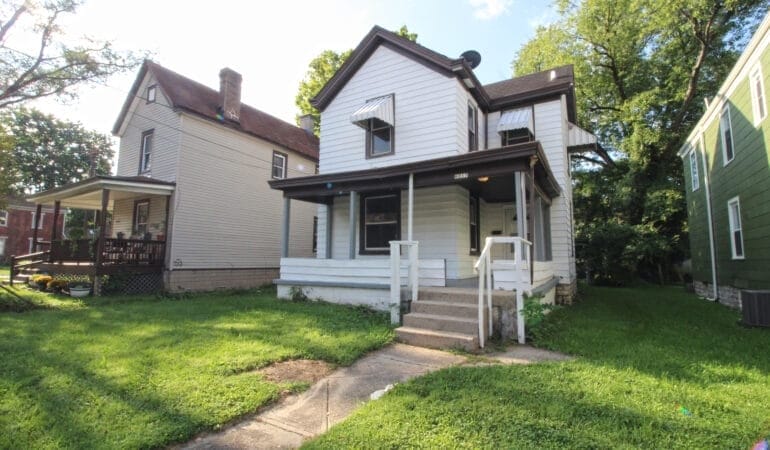Two years ago, the Port of Greater Cincinnati Development Authority pulled off something of a municipal miracle. The agency learned that almost 200 corporate-owned houses in Cincinnati were in receivership and up for sale. Rather than forever forfeit all that single-family housing to yet another institutional investor, the Port launched a bold bid to purchase the homes, with the goal of fixing them up and creating affordable homeownership opportunities for the existing tenants and other Cincinnati residents.
Well into the project, the Port would discover that many of the 194 houses it had purchased were in worse condition than expected, and dozens were vacant. “When we bought the portfolio, we thought there were only going to be 10 vacant, but 60 were vacant, and those were in really bad shape,” says Laura Brunner, the Port’s president and CEO. “So that’s where we’ve been focusing our capital investment, getting those homes ready to sell.”
The Port has now started selling the first of those fixed-up homes—19 of them so far—at affordable prices, to owner-occupants who earn less than 120 percent of the Area Median Income (AMI). The agency also helped stabilize the housing situations of the 130 or so renters in the other properties, addressing a backlog of hundreds of repair requests, helping tenants get current on their rent, and offering them free homebuying and financial literacy education.
Given the state of the houses, repairs and essential upgrades have cost more than double what the Port expected—averaging $96,000 per house so far, compared to a projected $40,000. But the agency has been able to make up the difference with grants so it can still sell the homes affordably, at cost. Unlike a house flipper, the Port only needs to break even to fulfill its debt obligations, not turn a profit.
In reclaiming rental houses from institutional landlords and converting them into homeownership opportunities, the Port is helping low- and moderate-income residents build generational wealth. And the agency’s approach is supporting sustainable growth in other areas of the local economy, too.
Spreading the Wealth
While homeownership itself has historically been an engine of wealth creation for millions of Americans, the real estate market is also a massive driver of economic activity in a community. New homebuyers tend to also buy new home goods, from dishes to lawn mowers, and a whole suite of local service providers participate in a home purchase, from appraisers to contractors.
So as the Port rehabs and sells what it calls its CARE (Creating Affordable Real Estate) Portfolio, it’s been very intentional about involving local businesses throughout the process.


“We’ve been really conscientious in our contracting to use small minority- and women-owned businesses,” Brunner says. With the cost of renovations averaging almost $100,000 per house, “the project size is perfect to really help grow and scale a small business. . . .And we’re not just giving them a contract and hoping they do a good job; we’re doing some technical assistance along the way to help them scale and grow their businesses sustainably.”
Rather than list the homes through an internal real estate agent, as it has historically done to save costs, the Port has partnered with Black-owned brokerages through the Greater Cincinnati Realtist Association (GCRA) to handle at least a quarter of the sales. The Port pays agents a standard commission, which adds some costs, but is essentially just another expenditure supporting local small businesses, Brunner says. “It’s helping to grow the whole ecosystem.”
The GCRA is a local chapter of the National Association of Real Estate Brokers, the oldest and largest African American trade organization in the country. “Prior to 1962, African Americans were not allowed to be members of NAR, the National Association of Realtors—or to even be called a Realtor, because that’s a trademarked name,” says Marcus Parrish, president of the GCRA. So in 1947, a group of 12 Black brokers, including Cincinnati hotelier Horace Sudduth, formed their own real estate organization, NAREB, whose agents would be called Realtists. “Our mission is democracy in housing—representing the underserved and providing education and resources,” Parrish says.
Only a quarter of Black households own their home in Cincinnati—less than half the homeownership rate of the city’s white families—and both the Port and Parrish hope that converting investor-owned rental units to affordable homeownership opportunities can help close that gap. “The Cincinnati market is just as challenging as any other market in the nation,” Parrish says. “Low housing inventory just creates a challenge for anybody who’s purchasing, but specifically for our first-time homebuyers and our Black and brown communities.”
A GCRA selection committee chose a handful of Realtists to handle the Port listings, although Parrish and other board members listed the very first batch of CARE portfolio houses themselves so they could get a feel for the process and work through any kinks. Buyers need to prove their income eligibility, and the houses include a deed restriction that prevents owners from reselling them for the first five years.
As for the renovations, the Port isn’t trying to chase HGTV trends or install high-end finishes, Parrish says; they’re focused on making the homes safe, efficient, and functional for first-time buyers. “I listed and sold two of those properties, and for the most part, the updates and rehabs have been good,” Parrish says. “If it needs a new furnace, needs new central air, if the roof is beyond repair, they’re going to do that.”
Early this year, Parrish sold a Port-rehabbed house at its list price of $165,000, and he recalls the ripple effects of the sale: The mortgage lender at First Financial Bank, who helped the Latino homebuyers get a five-figure down payment grant, also belonged to the GCRA, and so did the title company representative. “Everyone involved in the process was a member of our organization,” Parrish says.
That’s important, because Black brokers, agents, and appraisers are underrepresented (and often underpaid) in the real estate industry. Nationally, only 6 percent of real estate agents are Black; less than 2 percent of appraisers identify as Black. “The main thing is, you want to have representation, so the push is to get more African Americans in the real estate profession,” Parrish says.
Rent, Renovate, Replicate
While it renovates vacant houses, the Port is also acting as a landlord for over 100 households. The agency holds its contractors to high standards and offers technical assistance to ensure they succeed; it’s also been careful in its hiring practices.
Brunner says the Port was very close to signing a contract with one property management company until a company representative referred to the renters as “these people,” a rhetorical red flag. “That’s obviously coded for the kind of practices we’re trying to fight against—that ‘these people’ are not trustworthy, just assuming the worst,” Brunner says. “We had to have somebody that we could trust.” They hired a different firm.
In addition to addressing hundreds of repairs that the corporate landlord had ignored, the Port has helped dozens of tenants catch up on back rent—some of them were over a year behind. “We were successful in working with our local community action agency to secure ARPA funding to bring 60 of them current,” Brunner says, adding that “there’s a whole psychological benefit to knowing you’re current. We’ve got a good collection record now, after people were able to kind of wipe the slate clean with grants.”
The Port also hired a local nonprofit called Working in Neighborhoods to offer financial literacy training and first-time homebuyer classes to interested tenants. Many of the renters still lack the financial stability needed to buy a home, and some have been hesitant to engage with these resources. But about 60 of them have participated in the classes, and that’s helping to create a pipeline of potential buyers. “We’ve got maybe half a dozen who will be ready [to purchase a home] in the next six months, and half a dozen who’ll be ready in the next year,” Brunner says.
Even if it takes longer than expected to convert existing renters into homeowners, what the Port has accomplished is remarkable, says Robert ‘R.J.’ McGrail, senior fellow at the Lincoln Institute of Land Policy and director of its Accelerating Community Investment initiative.

“These are largely stabilized rental households now, and that is an extraordinary public policy outcome,” he says. Selling the rehabbed homes has enabled the Port to pay the debt service on its bonds, buying itself more time to move existing tenants along a track to homeownership. “It’s just win, win, win across the continuum of policy outcomes that you’d like to see from a financial intervention like this.”
Proof of Concept
Could the Port’s approach be replicated elsewhere? “Technically, transactionally, yes,” McGrail says. “There are debt-issuing authorities in other cities that have the powers to execute a financing transaction like this. There are fewer that have the rest of the Port’s powers around taxes and around landholding; they’re also a land bank, so they’re more empowered than your typical municipal financing-only entity. They can do it all in house.”
The Port also had plenty of previous experience hiring construction crews and managing properties, primarily for commercial properties. “That set of tools—the financing, the property management, plus the redevelopment expertise—is a unique set of competencies to have under one roof,” McGrail acknowledges, but there’s no reason this strategy couldn’t be replicated by a more typical financing entity working with civic and nonprofit partners. “You don’t need the one-stop shop to do this. You just need the will to tell three shops to do it together.”
Brunner says the Port has proven that the approach can be replicated and scaled. “We’ve shown that we can recover our costs, that you can buy a house, fix it up, and sell it for what you put into it,” she says. “We’ve established that, even in these poor neighborhoods, there is a market for ownership. And we’ve proven that, even with the highest interest rates in 20 years, many people can still own a home with a lower mortgage payment than what their rent was.”
What’s more, Brunner insists, it must be replicated. “We can all agree that our racial wealth gap is one of the biggest problems in our country,” Brunner says. “We can all agree that homeownership is the most direct way to increase wealth. So how can we not play whatever role we possibly can to make that possible for more people?”
Beyond the economics, she says, “there’s a moral imperative, for those of us in this country who can, to fight back against these institutional investors. It’s not a little thing, just every here and there a bad actor as a property owner; it’s become an epidemic. We cannot just give up on all these poor to moderate-income neighborhoods, and wipe out that potential of first-time ownership, largely for our Black and brown communities. We have to fight back.”
Jon Gorey is a staff writer at the Lincoln Institute of Land Policy.
Lead image: The Port of Cincinnati bought 194 homes formerly owned by institutional investors in neighborhoods across the city. Credit: Port of Cincinnati.








